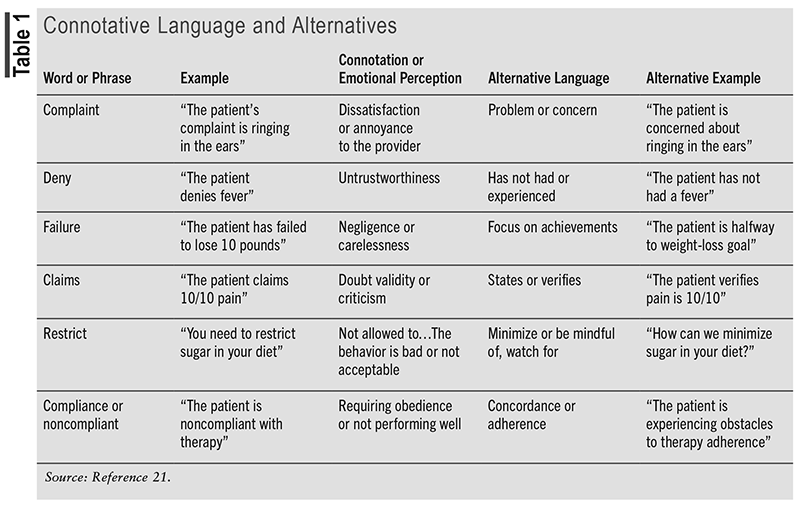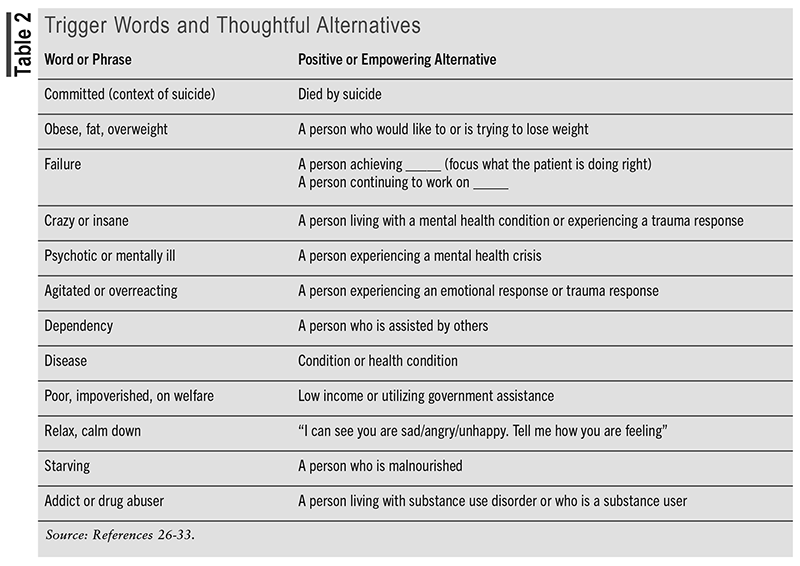US Pharm. 2023;48(9):40-42.
ABSTRACT: Pharmacists are the most accessible healthcare providers in the country, and more patients are seeking clinical services implemented by pharmacists. Communication between providers and patients has always been an area for improvement in practice. With the introduction of new models of care, such as trauma-informed care, healthcare providers can improve their patient relationships and recommendations. New evidence shows that habitual or outdated health communication, such as fear-based and scare-tactic messages, negative or connotative communication, and dismissive language, is no longer effective with today’s changing patient populations. Best practices now turn to thoughtful alternatives to trigger words using empowering and positive language.
With over 48% of Americans taking at least one prescription medication and almost one in four people taking three or more medications monthly, pharmacists are the most-encountered healthcare providers in the country.1 Evidence shows that pharmacists nationwide discuss medications and health conditions with over 140 interactions daily and over 141 million phone calls annually.2,3 However, communication continues to be a primary area for improvement across all healthcare professions.4
A growing trend in healthcare communication and education is trauma-informed care.5 Trauma results from “an event, series of events, or set of circumstances that is experienced by an individual as physically or emotionally harmful or life-threatening and that has lasting adverse effects on the individual’s functioning and mental, physical, social, emotional, or spiritual well-being.”6 Mental health agencies often describe three types of trauma: acute, chronic, and complex trauma.7 Chronic trauma is repeated, prolonged exposure to an emotionally harmful or life-threatening event, and complex trauma is exposure to varied and multiple traumatic events.8
Trauma is often thought of as specific events, but anything that causes a heightened sense of fear, feeling of being overwhelmed, isolation, and helplessness can result in trauma.9 Certain words, phrases, tone of voice, inflections, or body language can prompt or trigger these feelings.10 A trigger affects one’s emotional state, often causing distress or altering actions, and trigger words elicit an emotional reaction or lead patients to feel a certain way.11 The challenge for providers is that trigger words are personal to each individual and may not be as overt or evident as one might think.12 Therefore, best practices are replacing fear-based and scare-tactic, negative or connotative, and dismissive language with positive and empowering alternatives.
Fear-Based and Scare-Tactic Messages
Fear-based language and scare tactics have traditionally focused on moralistic, exaggerative, and abstract messages that intentionally cause visceral reactions and vivid imaginings of the consequences.13,14 These messages can be found in many areas of healthcare, such as smoking or substance use disorder, including such messages as “smoking causes lung cancer,” “alcohol causes congenital disabilities,” and “opiates can cause overdose death.”15 Evidence in adults is mixed; however, in adolescents and young adults, the research shows that fear-based and scare tactics are not always an effective motivation.15,16 Additionally, if a patient is triggered or becomes defensive by wording, phrasing, or imagery, the situation or behavior may worsen or not improve.16
Negative and Connotative Language
In healthcare, negative wording, phrasing, and connotative language are often not overt and may be linked to habit, implicit/explicit bias, personal background, and culture.17 Regardless of the origin or straightforwardness of negative language, evidence shows that it can perpetuate prejudice and trauma without regard to the provider’s true intent (see TABLE 1).18 A simple question such as “Are you male or female?” can be interpreted in several ways depending on the question’s tone, inflection, and placement. Negative language can be found when discussing or documenting weight, mental health conditions, substance use, socioeconomic situations, housing, and ability.19 Connotative language is used to express or have a connection to emotion and is often found in slang or colloquial terminology.20 Connotative language that is indirect and does not utilize plain language can be perceived as or purposefully linked to triggering judgment, stigma, or bias.21

Dismissive Language
Another commonly found trend in healthcare communication is dismissive language. Dismissive language, also called medical gaslighting, makes patients feel as if their concerns are not warranting attention, are being minimized, or are ignored altogether.22 Phrases such as “it could be worse,” “relax,” “don’t worry,” “I’m sorry,” or “I understand” could have the intention of trying to make the person feel better; however, they are perceived by patients as placating and even patronizing.23 Dismissive language leads to the patient not seeking preventative treatment, not following up with concerns, not following recommendations, not asking questions, and experiencing decreased overall confidence.24
Empowering and Positive Language
Although fear-based, scare-tactic, negative, and connotative language may be used with good intentions or intended to persuade patients benevolently, these language choices can ultimately trigger patients and evoke trauma responses.25 Best healthcare practices now encourage thoughtful alternatives to trigger words using empowering and positive language (see TABLE 2).26

Conclusion
Thoughtful communication in healthcare is about allowing patients autonomy in their care, expanding representation, avoiding assumptions, and ultimately improving patient health outcomes through positive provider interactions. Using positive and empowering words not only improves patient satisfaction and reduces healthcare costs; most importantly, it also bolsters the physical and mental health of patients.
REFERENCES
1. CDC. Therapeutic drug use. February 24, 2023. www.cdc.gov/nchs/fastats/drug-use-therapeutic.htm. Accessed July 8, 2023.
2. Drugtopics.com. www.drugtopics.com/pharmacy-news/pharmacist-workload-and-time-management. Accessed July 8, 2023.
3. Ward-Charlerie S. The perfect prescription: obstacles and opportunities on the path to higher quality and lower costs. Surescripts.com. https://surescripts.com/docs/default-source/intelligence-in- action/prescription-accuracy/2018_feb_position-paper_prescription-accuracy.pdf?sfvrsn=2. Accessed July 8, 2023.
4. Approach to improving patient safety: communication. https://psnet.ahrq.gov/perspective/approach-improving-patient-safety-communication. Accessed July 8, 2023.
5. Brown T, Berman S, McDaniel K, et al. Trauma-informed medical education (TIME): advancing curricular content and educational context. Acad Med. 2021;96(5):661-667.
6. Samhsa.gov. Trauma and violence. January 14, 2019. www.samhsa.gov/trauma-violence. Accessed July 8, 2023.
7. Evans A, Coccoma P. Trauma-informed care: how neuroscience influences practice. 2014. https://earlyconnections.mo.gov/professionals/trauma-informed-care. Accessed July 8, 2023.
8. National Child Traumatic Stress Network. Complex trauma. January 25, 2018. https://www.nctsn.org/what-is-child-trauma/trauma-types/complex-trauma. Accessed July 8, 2023.
9. Substance Abuse and Mental Health Services Administration. Center for Substance Abuse Treatment (US). Understanding the impact of trauma. 2014.
10. Safesupportivelearning.ed.gov. https://safesupportivelearning.ed.gov/sites/default/files/Triggers.pdf. Accessed July 8, 2023.
11. Heels Care Network. Understanding mental health triggers. January 27, 2022. https://care.unc.edu/understanding-mental-health-triggers/. Accessed July 8, 2023.
12. Ponte K. How to be a mental health ally. Harv Bus Rev. May 9, 2022. https://hbr.org/2022/05/how-to-be-a-mental-health-ally. Accessed July 8, 2023.
13. Tannenbaum MB, Hepler J, Zimmerman RS, et al. Appealing to fear: a meta-analysis of fear appeal effectiveness and theories. Psychol Bull. 2015;141(6):1178-1204.
14. Not your mother’s scare tactics: the changing landscape of fear-based messaging research. EDC.org. https://solutions.edc.org/sites/default/files/Not-Your-Mothers-Scare-Tactics-Brief-The-Changing-Landscape-of-Fear-based-Messaging_0.pdf. Accessed July 10, 2023.
15. Prevention Action Alliance. Scare tactics in prevention. October 9, 2020. https://preventionactionalliance.org/learn/about-prevention/scare-tactics-in-prevention/. Accessed July 10, 2023.
16. Kok G, Bartholomew LK, Parcel GS, et al. Finding theory- and evidence-based alternatives to fear appeals: intervention Mapping: alternatives to fear appeals. Int J Psychol. 2014;49(2):98-107.
17. FitzGerald C, Hurst S. Implicit bias in healthcare professionals: a systematic review. BMC Med Ethics. 2017;18(1):19./
18. Park J, Saha S, Chee B, et al. Physician use of stigmatizing language in patient medical records. JAMA Netw Open. 2021;4(7):e2117052.?
19. Vela MB, Erondu AI, Smith NA, et al. Eliminating explicit and implicit biases in health care: evidence and research needs. Annu Rev Public Health. 2022;43(1):477-501.
20. Texasgateway.org. Denotation and connotation (English II reading). www.texasgateway.org/resource/denotation-and-connotation-english-ii-reading. Accessed July 10, 2023.
21. Cox C, Fritz Z. Presenting complaint: use of language that disempowers patients. BMJ. 2022;377:e066720.
22. Hildenbrand GM, Perrault EK, Rnoh RH. Patients’ perceptions of health care providers’ dismissive communication. Health Promot Pract. 2022;23(5):777-784.
23. Fraser S. The toxic power dynamics of gaslighting in medicine. Can Fam Physician. 2021;67(5):367-368.
24. Grissinger M. Disrespectful behavior in health care: its impact, why it arises and persists, and how to address it-part 2. Pharm Times. 2017;42(2):74-77.
25. Busch B, McNamara T. Language and trauma: an introduction. Appl Linguist. 2020;41(3):323-333.
26. Srivastava SB. Language: a powerful tool in promoting healthy behaviors. Am J Lifestyle Med. 2019;13(4):359-361.
27. The Mental Health Coalition. Language Guide. Published online May 2020. Accessed July 08, 2023. https://www.thementalhealthcoalition.org/wp-content/uploads/2020/05/The-Mental-Health-Coalitions-Language-Guide.pdf.
28. Rubino F, Puhl RM, Cummings DE, et al. Joint international consensus statement for ending stigma of obesity. Nat Med. 2020;26(4):485-497.
29. EndocrineWeb Pro. Talking to patients about obesity: patient-first communication. March 1, 2021. https://pro.endocrineweb.com/clinicians-guide-talking-patients-about-obesity/chapter-5-clinician-script-patient-fi-0. Accessed July 8, 2023.
30. Specht C. 10 Ways to Combat Discrimination with Compassionate Language. Published online February 2019. Accessed July 08, 2023. https://www.dbsalliance.org/wp- content/uploads/2019/02/DBSA_language.pdf
31. Apa.org. https://apastyle.apa.org/style-grammar-guidelines/bias-free-language/socioeconomic-status. Accessed July 10, 2023.
32. Cameron D. 10 alternatives to saying “calm down.” Early Childhood Professional. April 27, 2020. https://earlychildhoodprofessional.com/alternatives-to-calm-down/?expand_article=1. Accessed July 10, 2023.
33. Corbin M. Words matter—terms to use and avoid when talking about addiction. Postgraduate Institute for Medicine and National Institute on Drug Abuse. July 15, 2021. https://nida.nih.gov/nidamed-medical-health-professionals/health-professions-education/words-matter-terms-to-use-avoid-when-talking-about-addiction. Accessed July 08, 2023.
The content contained in this article is for informational purposes only. The content is not intended to be a substitute for professional advice. Reliance on any information provided in this article is solely at your own risk.
To comment on this article, contact rdavidson@uspharmacist.com.






